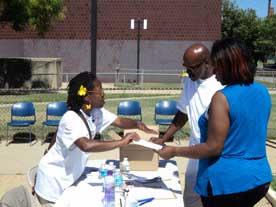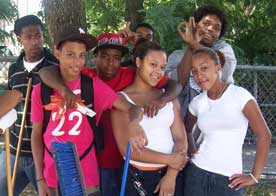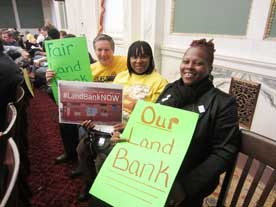In 2005, organizing group ONE DC secured its first local hiring agreement, with an Embassy Suites Hotel. Thirty long-time residents graduated from a job readiness program, and some of those moved forward with job training, but in the end just seven were offered permanent jobs.
This year, when what is now the largest hotel in Washington, D.C., the Marriott Marquis, opened, a full 500 of its 1,100 employees were D.C. residents, thanks again to a local hiring agreement orchestrated by ONE DC. But the journey isn’t over.
The Marriott Marquis journey began in 2006, when a bill was drafted that contained an agreement from Marriott to hire at least 500 longtime D.C. residents who made it through a training program. ONE DC’s organizers had learned from their experience with Embassy Suites, however, that a local hiring agreement is only as good as the recruitment and enforcement that go with it. They wanted to hold the city and Marriott accountable for Marriott’s promise, and so decided to campaign to get themselves named in the legislation as a designated outreach partner.
“We didn’t want Marriott to say, ‘Oh, we’ll hire 500 people’ but then say there wasn’t anyone eligible for the training program,” says Jessica Gordon Nembhard, ONE DC’s board president. They wanted to be named in the legislation “so we could be at the table to make sure that happened. . . . If we didn’t have city money [to do outreach work], no one was going to . . . make sure we had enough people eligible for Marriott training.”
ONE DC knew it would need to spend years organizing to disprove the common myth of “not enough qualified residents” and began to petition the city to set aside $2 million for what would be D.C.‘s first resident-led job training and hiring program.
For the next three years, ONE DC organized around accountability, transparency, outreach, and training goals. It used direct action, street art, and protests, and conducted education around why organizing itself was necessary to the local hiring process. In 2009, ONE DC was named as one of the official partners in the development of a job training and local hiring program and given the role of recruiting people to apply for the training.
ONE DC’s persistence got it a seat at the table in other ways as well. Events DC, the district’s convention authority, which was charged with creating the job training program from which Marriott would hire, allotted two seats to ONE DC on the committee that hired a service provider to create the job training program.
A New Path
ONE DC, formerly Manna CDC until it spun off from its founding parent organization, Manna, Inc., was founded in 1997 in the Shaw neighborhood. Its mission includes “the identification and dismantling of systematic influences such as racism, classism, and sexism that manifest both individually and institutionally.”
ONE DC operates under three principles: involving the grassroots in the decisions that affect their lives; minimizing hierarchy and professionalism in organizations working for social change; and engaging direct action to resolve social problems.
The organization itself is run by shared leadership with no executive director, and puts community input at the forefront of its work on right to housing, right to income, and right to wellness campaigns.
For ONE DC to get both such a hiring agreement with Marriott and a seat in the table to implement it were big wins. ONE DC resource organizer Dominic Moulden says the jobs being offered even count as “good jobs”—paying living wage, receiving fair benefits, and free from discrimination—and the workers will likely have the option to be in a union in the future.
But ONE DC’s goals were even bigger. It also wanted a new kind of workforce development process that would really bring those good jobs within reach for not just any D.C. residents, but those who most need them and most struggle to get them, including the long-term unemployed and very low income.
ONE DC’s staff envisioned a job-training program that would not be a battle with the residents who need it the most, as D.C.‘s most vulnerable residents have come to know such programs to often be. They envisioned a new model where organizers, and in turn, the community, had power along with the employer.
But this was a harder nut to crack, and as the job-training program comes to a close and ONE DC reflects on the last year, Moulden describes the overall feeling he’s left with: “We wouldn’t want to do it again if we had to do it this way.”
As organizers, ONE DC reached over 3,000 people to apply for the job-training program. About half were accepted, and about half of those will be offered jobs over the next year as construction at the hotel is completed, a number ONE DC knows sounds great to hear.
But under these numbers are a lot of concerns about who is really getting reached, and how. ONE DC’s role in recruitment was important because its staff understood that the people they work with often don’t see job training as worth their time, after many bad experiences with trainings that disrespected them as workers and people, and didn’t lead to jobs anyway. “People are fed up with the idea that they have to be God’s special snowflake to get into a job training program that doesn’t lead to a job, so when they hear about job training, they are immediately skeptical,” says ONE DC organizer Reece Chenault. “Our residents are not served by job training programs that require them to be broken like horses for a job.”
ONE DC had hoped that this program could be different. But even with its seat at the table, in the end, ONE DC’s organizers were not able to have as much influence over the workforce development program as they had hoped.
For example, they had envisioned a process where the definition of acceptable identification would be greatly expanded. A need for multiple forms of ID from a narrow list typically favors applicants along race, class, and gender lines, and by zip code, and is a particular to barrier to LGBT people, the formerly incarcerated, and the long-term unemployed.
For example, Chenault explains, “If you’re dealing with low-income folks, they may not have a drivers license. They may not have an electric bill. If you’re living in a place with somebody else like your sister or cousin, you may not be on the lease. For a lot of folks, just getting to an information session was really difficult. Having to take a couple of buses takes a long time. If people needed to get ID and come back … are they really going to come back?”
However, Moulden said the service providers involved insisted on the standard types of identification, saying that letters and the other alternatives that ONE DC proposed could not be verified. ONE DC argues that if the goal is to help the applicants, they should not be met with automatic suspicion off the bat.
The conversation around ID is symbolic of the broader problematic tone of workforce development programs, Chenault says. He says as organizers they hear from their constituents frequent stories about how these programs reinforce a level of institutional racism by assuming that certain manners of dressing or speaking that are associated with black culture are not appropriate to a workplace, even though they have no actual bearing on a person’s professionalism or skills. While a job training program may wish to warn trainees that an employer may carry these biases, that is a different thing from adopting and reinforcing them as legitimate, though in both cases the service provider may believe it is serving its goal of helping someone become employed.
ONE DC wanted to talk about this tension openly and explore ways to address it through the Marriott job training process, but they found that without a common understanding about the nuances of racism and white privilege among all the partner organizations, that the conversation couldn’t go very far. Moulden says if ONE DC were to go about the process of crafting a job training program with multiple partners again, it would insist on some sort of “consciousness raising for all the partners [on] institutional racism, sexism, classism,” before the actual program began.
“In the end, we don’t need programs that produce more anger and frustration. We need programs that respect workers and treat them like human beings, not commodities to be traded,” Chenault says.
Nonetheless, the program is still a win, Moulden says. ONE DC followed the lead of its residents in taking on the issue, and the level of involvement they as radical organizers had was unprecedented. Moulden notes that their insistence on focusing on structural change “is challenging the service providers and challenging Marriott” and has given the organization an inside look into how such a program works, which they can share with others. “We’ve been able to be ourselves even though it’s been scary for the partners and Marriott,” he says.
Going Forward
Despite its disappointments, ONE DC is finishing out its contract on the project, providing support for workers who have issues that come up on the job and evaluating the results of its participation. But meanhile, it’s also focusing on what it does best: organizing. ONE DC is currently seeking out and organizing the people who were not accepted into the Marriott job training program, learning from them about how structural unemployment works and what would serve them better. (ONE DC’s leaders were upfront about their desire to do this and asked from the beginning for the contact information for applicants who had been rejected, but have not yet received it.)
ONE DC is planning to continue to advocate for more community benefit agreements, participate in coalitions to improve the city’s enforcement of its local hiring legislation, encourage residents to apply for existing living wage job opportunities, and work with residents for better job security through organizing collective enterprises like worker cooperatives.
In that vein, it is also creating a Black Worker’s Center in D.C. to build power and support black workers, looking especially to include those who were rejected from the Marriott training. ONE DC is also embarking on a partnership with Georgetown University’s Kalmanovitz Initiative for Labor and the Working Poor to develop a report on the Marriott process and its outcomes.
“The kind of organizing we do means you don’t just stop when you get one of the wins,” says Nembhard. “You have to somehow stay alive.”
For Chenault, that means keeping up hope for himself along with residents as he goes door to door and collects the stories of those turned away from the job training program. “Ten years ago, ONE DC thought that this would never happen—that there would be any community involvement in any [workforce development] process and certainly not with some of the results we got,” he says. “We have to reenter the fray.”





Comments